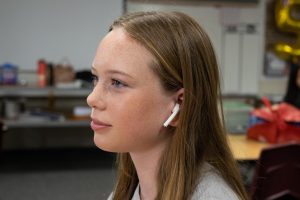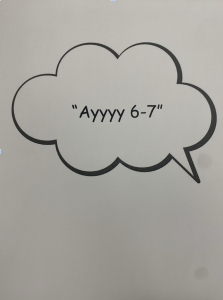Learning with EASE
Etiwanda’s EASE programs are gaining popularity due to the COVID-19 pandemic.
January 15, 2021
At the conclusion of the 2019-2020 Summer Break, three learning models were presented to all families of children enrolled in the Etiwanda School District. The hybrid learning model came first, which consisted of students coming onto campus for half days on Tuesdays through Fridays. The virtual learning model was the next option, requiring students to learn from home while receiving daily instruction on Zoom and completing and submitting work through an online platform. The final two options were mostly unfamiliar to students and their families: the Etiwanda Alternative Study Education homeschool program and the Etiwanda Alternative Study Education independent study program.
The EASE homeschool program provides a method for students to complete their work from home but still have teacher check-ins and, if needed, instruction from time to time. Students have all of their work assigned to them online. They generally receive help from their parents and meet with a teacher or tutor biweekly.
“When you come to the homeschool model, you actually don’t use the Etiwanda textbooks; you use the K12.com program. But all we use is their curriculum and their online platform. The teachers come from Etiwanda. So what the teachers do is a bi-weekly, so every two week, check-in for about a half hour with the student to see if they have any questions or any concerns. It’s the student and the parent,” said Michelle Jacks, the EASE coordinator.
This program has been a part of the ESD for quite some time. For students who aren’t able to come to a campus regularly, this allows them a flexible way to learn on their own time. It also provides an option for students who need to go at their own pace and don’t want the stress of daily assignments. These kids are often athletes, child actors or special education students. The homeschool program is a trimester-long commitment, and parents pay about $500 per year for any textbooks, materials or special instruction needs.
The EASE independent study program is similar to the homeschool model, but it has one major difference. There is no class instruction given by ESD teachers. Work is assigned online and parents are the sole instructors for their students.
“(For the EASE independent study program) we have the Etiwanda textbooks and then we have three teachers that (make) lesson plans for TK-8th grade, every week of the year. And they plan exactly what (is needed) for each subject, day by day. The kids have to do it on their own. If they need any help, we have instructional aids they can meet, and this happens in the homeschool program as well,” said Mrs. Jacks.
This model was recently introduced because of the COVID-19 pandemic. While the EASE homeschool program is a trimester-long and sometimes costly commitment, this was a simple option for families who weren’t quite sure how things would look. If the Etiwanda School District reverts to the hybrid learning model at any time this year, EASE independent study students would have the option to switch to hybrid learning. And if students wanted teacher instruction and didn’t choose to return to school, EASE independent Study students could also transition to the virtual learning model with no major contractual hiccups.
Students and parents who chose these models definitely see the fruits of their decision. The programs allow more flexibility for everyone, providing room for kids and their parents to adjust their school schedules as needed.
“My parents are always working, so it’s very minimal (that they) check in on me; it’s just kind of doing work. I start (my work) mid-afternoon and end-afternoon, but I usually do one subject, like one thing from a subject each day and then spread it out, throughout the week,” said eighth grader Grace G., who is enrolled in the EASE independent study.
With all of ESD being virtual for the time being, students and staff are constantly relying on Zoom meetings for all necessary interaction. Because of this, students could be on their computer screen for up to six hours each day, four of which could be Zoom meetings. With the EASE learning programs, this can be avoided since the enrolled students are not required to meet daily with teachers.
“I didn’t want (my daughter) to have to sit in front of the computer screen. I saw her try to do that when everything happened in March and she didn’t interact very well on the screen, she seemed kinda nervous. I also didn’t want her to have to be forced to have her be on there (computer screen),” said Christine Carson, mother of a kindergartener in the EASE independent study.
The flexibility and freedom provided by the EASE learning programs allows for a lot of stress to be relieved from students and parents alike. The work, when spread out across the assigned week, is rarely as overwhelming as having daily assignments like those required for virtual and hybrid students.
“We can do school whenever during the week that we want to. We spend a little more time doing school on a good day and then on a bad day, we can cut it short. I find it very beneficial to have access to the resources and be able to choose what I need for her. I don’t feel overwhelmed by having to complete everything. And I find that very helpful. I enjoy the flexibility,” said Carson.
Despite all of their advantages, the homeschool and independent study programs also have their concerns. While some see the avoidance of Zoom as a positive, it can also serve as a negative. EASE students lack the opportunity for social interaction because of their lack of meeting or instructional time. In contrast, hybrid and virtual students use breakout rooms for small groups where they can chat with friends about daily life and school work. Students in other models don’t have that option.
“Both programs don’t have the Zoom interactions with the classroom. You guys (hybrid and virtual students) get to be in the Brady Bunch squares and see each other, have breakout sessions and have group discussions. We don’t have that capability right now in what we do. So a big (downside) would be not having that tether with that daily teacher or with those daily classmates,” said Mrs. Jacks.
The lack of instructional time could also cause students to procrastinate. Without constant reminders of when things are due, kids may forget homework or keep pushing it aside until the last minute. EASE students can also only depend on a guardian or older sibling to assist with questions, which could present a gap in knowledge of certain subjects.
“Well sometimes it does get a little challenging and you could just like never do it because you can just do it whenever, so you could push it off a lot. You have to be responsible because you can just easily not do school for a month,” said eighth grader Kailani D., who is enrolled in the EASE homeschooling program.
The EASE homeschooling program and the EASE independent study program both prove to be optional experiences for the enrolled students. Despite the drawbacks to each program, the flexibility, screen breaks and stress relief have made this school year much easier for many families.
“This way is kinda fun. It’s like my own independence. I think this was just easier,” said Grace G.






